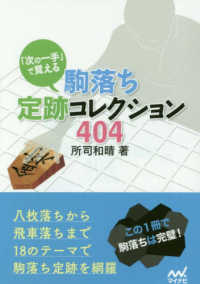- ホーム
- > 洋書
- > 英文書
- > Science / Mathematics
Full Description
Introduction to Digital Signal Processing covers the information that the undergraduate electrical computing and engineering student needs to know about DSP. KEY TOPICS: Core material, with necessary theory and applications, is presented in Chapters 1-7. Four unique chapters that focus on advanced applications follow the core material. MATLAB (R) is heavily emphasized throughout the book. Most applications have an accompanying lab or sequence of homework problems that have a lab component. MARKET: Ideal for a junior- or senior-level course for students of electrical and computer engineering. It is also suitable for self-study by practicing engineers with little or no experience with digital signal processing.
Contents
1.1 What is a digital filter? The analog circuit analysisA digital filter replacement1.2 Overview of Analysis and DesignThe Analysis ProcessThe Design ProcessCHAPTER 2 Discrete-Time Signals2.0 Introduction2.1 Discrete-Time Signals and SystemsUnit Impulse and Unit Step Functions Related operations2.2 Transformations of Discrete-Time SignalsTime TransformationsAmplitude Transformations2.3 Characteristics of Discrete-Time SignalsEven and Odd SignalsSignals Periodic in nSignals Periodic in &2.4 Common Discrete-Time Signals2.5 Discrete-Time Systems2.6 Convolution for Discrete-Time SystemsImpulse representation of discrete-time signalsConvolutionProperties of convolutionPower gainChapter SummaryCHAPTER 3 Frequency Domain Concepts3.0 Introduction3.1 Orthogonal Functions and Fourier SeriesThe Exponential Fourier SeriesDiscrete Fourier Series3.2 The Fourier TransformDefinition of the Fourier TransformProperties of the Fourier TransformFourier Transforms of Periodic Functions3.3 The Discrete-Time Fourier TransformThe Discrete-Time Fourier Transform (DTFT)Properties of the Discrete-Time Fourier TransformDiscrete-Time Fourier Transforms of Periodic Sequences3.4 Discrete Fourier TransformShorthand Notation for the DFTFrequency resolution of the DFT3.5 Fast Fourier TransformDecomposition-in-Time Fast Fourier Transform AlgorithmApplications of the Discrete / Fast Fourier TransformCalculation of Fourier TransformsConvolution Calculations with the DFT/FFTLinear Convolution with the DFTComputational Efficiency3.6 The Laplace TransformProperties of the Laplace transformTransfer functionsFrequency response of continuous-time LTI systems3.7 The z-TransformDefinitions of z-Transformsz-TransformsRegions of ConvergenceInverse z-Transformsz-Transform PropertiesLTI System ApplicationsTransfer FunctionsCausalityStabilityInvertibilityDiscrete-Time Fourier Transform-z-transform RelationshipFrequency Response CalculationChapter SummaryChapter 4 Sampling and Reconstruction 4.1 Sampling Continuous-Time Signals Impulse SamplingShannon's sampling theoremPractical sampling4.2 Anti-aliasing FiltersLow pass analog Butterworth filtersA low pass Butterworth analog filter has a transfer function given by Switched-capacitor filtersOversampling4.3 The Sampling ProcessErrors in the sampling process4.4 Analog to Digital ConversionConversion techniquesSuccessive Approximation ConverterFlash ConverterSigma-Delta ConversionError in A/D conversion processDither4.5 Digital to Analog ConversionD/A conversion techniques4.6 Anti-Imaging FiltersChapter 5 FIR Filter Design and Analysis 5.1 Filter Specifications5.2 Fundamentals of FIR Filter DesignLinear phase and FIR filtersConditions for linear phase in FIR filtersRestrictions Imposed by SymmetryWindow Functions and FIR FiltersHigh pass, band pass, and band stop filters5.3 Advanced Window FunctionsKaiser WindowDolph-Chebyshev window5.4 Frequency Sampling FIR filters5.5 The Parks-McClellan Design Technique for FIR filters5.6 Minimum Phase FIR filters5.7 ApplicationsMoving Average FIR FilterComb FiltersDifferentiatorsHilbert Transformers5.8 Summary of FIR CharacteristicsChapter 6 Analysis and Design of IIR Filters6.1 Fundamental IIR design Using the Bilinear TransformExample 6.16.2 Stability of IIR Filters6.3 Frequency transformations6.4 Classic IIR filtersThe Butterworth FilterChebyshev FiltersInverse Chebyshev filterElliptic FiltersSummary of Classic IIR FiltersInvariant Impulse Response6.5 Poles and Zeros in the z-Plane for IIR FiltersSummary of pole and zero locations for IIR filters6.6 Direct Design of IIR FiltersDesign by pole/zero placementDesign of resonators and notch filters of second orderNumerical Direct Design - Pade methodNumerical Direct Design - Prony's methodNumerical Direct Design - Yule-Walker method6.7 Applications of IIR FiltersAll Pass FiltersIIR Moving Average FiltersIIR Comb FiltersInverse FiltersChapter SummaryChapter 7 Sample Rate Conversion7.1 Integer DecimationFrequency spectrum of the down sampled signalCascaded Decimation7.2 Integer InterpolationCascaded Interpolators7.3 Conversion by a Rational Factor7.4 FIR ImplementationDecimation filtersInterpolation filters7.5 Narrow Band Filters7.6 Conversion by an Arbitrary FactorHold interpolationLinear Interpolation7.7 Bandpass Sampling7.8 Oversampling in Audio ApplicationsChapter SummaryChapter 8 Realization and Implementation of Digital Filters8.1 Implementation Issues8.2 Number RepresentationTwo's ComplementSign/MagnitudeFloating point representation8.3 Realization StructuresFIR StructuresIIR StructuresState Space Representation8.4 Coefficient Quantization Error8.5 Output Error due to Input Quantization8.6 Product Quantization8.7 Quantization and Dithering8.8 Overflow and Scaling8.9 Limit Cycles8.10 DSP on MicrocontrollersMicrocontroller Characteristics for DSPImplementation in CFIR Implementation in CIIR Implementation in CSpeed optimizationChapter 9 Digital Audio Signals9.1 The Nature of Audio Signals9.2 Audio File CodingPulse Code ModulationDifferential Pulse Code Modulation9.3 Audio File FormatsLossless file format examplesLossless compressed format examplesLossy compressed format examples9.4 Audio EffectsOscillators and signal generationDelayFlangingChorusTremolo and VibratoReverberationThe Doppler EffectEqualizersChapter SummaryChapter 10 Introduction to Two-Dimensional Digital Signal Processing10.1 Representation of Two-Dimensional SignalsProperties of Two-Dimensional Difference Equations10.2 Two-Dimensional TransformsThe Z-Transform in Two DimensionsThe two-dimensional Discrete Fourier TransformProperties of the 2D DFTThe Two Dimensional DFT and ConvolutionThe Two-Dimensional DFT and OpticsThe Discrete Cosine Transform in Two Dimensions10.3 Two-Dimensional FIR FiltersWindow methodFrequency Sampling in Two-DimensionsTransform methodsApplying FIR Filters to ImagesChapter SummaryChapter 11 Introduction to Wavelets11.1 Overview11.2 The Short Term Fourier Transform11.3 Wavelets and the Continuous Wavelet TransformThe HAAR WaveletThe Daubechies WaveletOther Wavelet Families11.4 Interpretation of the Wavelet Transform Data11.5 The Undecimated Discrete Wavelet Transform11.6 The Discrete Wavelet TransformChapter SummaryAPPENDIX A Analog Filter DesignA.1 Analog Butterworth FiltersA.2 Analog Chebyschev FiltersA.3 Analog Inverse Chebyschev FiltersA.4 Analog Elliptic FiltersA.5 Summary of analog filter characteristicsAPPENDIX B BibliographyAPPENDIX C Background MathematicsC.1. Summation Formulas for Geometric SeriesC.2. Euler's RelationC.3. Inverse Bilateral Z-Transforms by Partial Fraction ExpansionC.4. Matrix AlgebraC.5 State Variable EquationsAPPENDIX D MATLAB (R) User Functions and CommandsD.1. MATLAB User FunctionsD.2. MATLAB Commands








